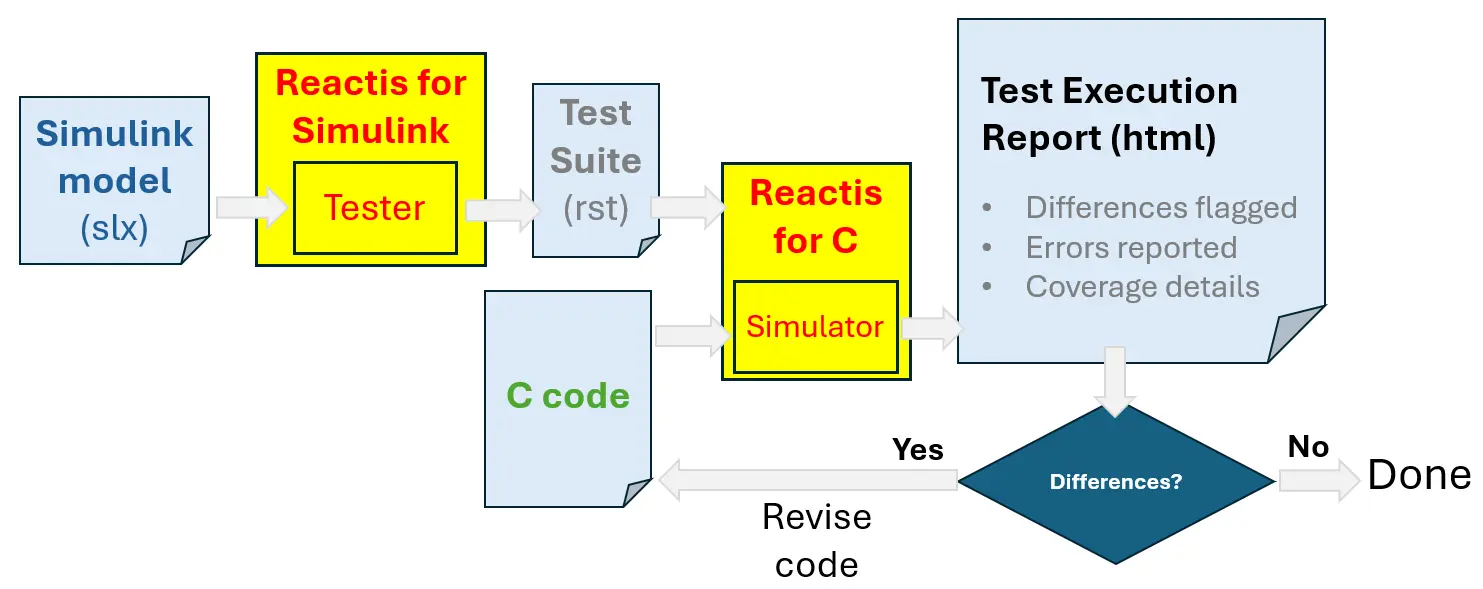4. Testing C Code Against Simulink Model#
The automatic test-generation and execution offered by Reactis enables engineers to easily check whether an implementation conforms to the behavior specified in a model.
The benefits of model debugging and validation were discussed in prior sections. A question that immediately presents itself is: How can the effort expended on these activities be reused to support the testing of system implementations? This is the question addressed in this section.
4.1. Software Testing#
A crucial aspect of the tests generated by Reactis Tester is that they store both input values and model outputs. Therefore, these tests encode all the information needed to ensure that source code conforms to its model. Reactis-driven source-code testing proceeds as follows:
For each test in the suite, execute the software using the input values contained in the test.
Compare the output values produced by the software with those stored in the test.
Record any discrepancies.
This methodology is referred to as model-based software testing or back-to-back testing. Its key advantage is that the model serves as an oracle for testing purposes: the outputs produced by the model can be used as a basis for assessing those generated by the software. If the software does not agree with the model, then the developer can assume that the problem lies within the source code.
The net effect of model-based testing with Reactis is better-quality software at a lower cost. Because good test data is generated and run automatically, less engineer time is required to create and run tests. Because the tests are thorough, the probability of finding bugs is maximized. Because the test suites are compact they may be run quickly. In sum, Reactis dramatically reduces the costs of testing embedded control software.

Fig. 4.1 Testing for conformance of C code to Simulink model with Reactis.#
Figure 4.1 illustrates how the Reactis tool suite can provide advanced model-based testing of source code. As the figure indicates, the model-based testing protocol supported by Reactis is as follows:
The developer provides as input to Reactis an .slx file representing the validated Simulink/Stateflow model of the system under development.
Reactis Tester is used to automatically generate a test suite that thoroughly exercises the given model according to the various coverage metrics supported by Reactis.
The developer may deploy Reactis Simulator to visualize test execution and to fine tune the tests in the test suite to further improve model coverage.
The test suite and the C code implementing the model are fed as inputs into the Simulator component of Reactis for C. Reactis for C will then read the native test suite format, execute the tests on the C code, flag any runtime errors, track coverage within the C code, and compare the outputs computed by the C code against those generated by the model and stored in the tests.
By comparing the outputs produced by the software against the model-generated outputs (stored in the test), deviations in the behavior of the source code from the model are readily detectable and help the developer ensure that the source code conforms to the model.
Testing concludes when the source code passes all the tests in the test suite.
4.2. System Testing#
After software testing, the next step in certifying a system is to compile the code and test the resulting executable on the platform, including the target microprocessor and associated system software, on which it will eventually be deployed. Such testing is often referred to as system, or integration, testing.
System testing typically involves the use of hardware-in-the-loop (HIL) simulation tools. These HIL tools are expensive, and thus using them as efficiently as possible can promote significant cost savings.
Provided that system-level models are given in Simulink / Stateflow, Reactis can greatly facilitate system testing. As in the case of software testing, test engineers can use Reactis Tester and Reactis Simulator to generate thorough yet compact test suites from these models and feed the test data into their HIL environments in order to check system behavior against model behavior. The compactness of Reactis-generated tests means that expensive HIL hardware need not be tied up with long test runs in order to get precise insights into system behavior.
How the Reactis-generated test data may be used in HIL testing will in general depend on the HIL environment used. HIL tools typically provide a scripting facility for defining test runs. Reactis exports test data in several easy to parse formats (comma separated value, CSV, for example) to simplify the writing of scripts to read Reactis-generated test data into an HIL environment.